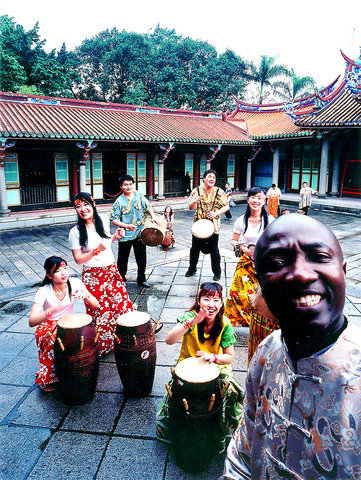Fresh from its success in the performing arts category of the Taishin Art Awards earlier this year, the Ju Percussion Group is once again looking to find new horizons and new musical challenges. For its newest show, Africussion!, which debuts Sunday at the National Theater in Taipei, Ju Percussion has sought inspiration from African music, provided on this
occasion by the Hamambee Dance Company of New York.
The concert of percussion music will include original works by members of the Ju Percussion Group who have composed African-themed music, while Hamambee will be providing support and the visual spectacle that aims to make this Ju Percussion both an audio and a visual experience.

Hwang Kuen-Yean, who's Rhapsody of Amadinda will open the concert, said of the cooperation between Ju Percussion and Hamambee: "Actually, both Africa and China make considerable use of percussion music in daily life. The two types of percussion music differ in that African percussion tends to express itself in dance, while Chinese percussion is predominantly used in opera. But in both cases material is drawn extensively from daily life. When we found the common ground between Chinese and African percussion, the creative process for this concert ran very smoothly and naturally."
Hwang's composition makes use of a Ugandan instrument, the amadina, which is a kind of xylophone. Originally this instrument was made simply by placing 12 logs on fresh banana stems. In fact, the name simply means "big keys" and this largish instrument is most often played by more than one performer.
According to Hwang, Rhapsody incorporates Taiwan folk songs into an African-themed composition. It is all about fusion these days, and Ju Percussion certainly has shown itself to have the technical skills to engage in this often perilous exercise. As if to underline Ju Percussion's technical skills, Rhapsody has six performers playing four instruments and achieving a pulsing rhythm of 480 beats per minute.
The piece of music from which the concert takes its name, Africussion by Hung Chien-hui (
Ju Percussion has already made a name for itself internationally, but, not content to merely maintain a heavy performance schedule, it has also made enormous efforts over the years in international artist exchanges that have greatly enriched its repertoire.
On this occasion its partners are the Harambee Dance Company founded by Frank and Sandella Malloy, who established the company as a way of fusing traditional African music with contemporary dance. Like the Ju Percussion Group, it is very involved in music and dance education, and its participation in Africussion! has allowed Ju to extend its range and experience for the enjoyment of the growing number of percussion aficionados in Taiwan.
Event information:
What: Ju Percussion Group and Harambee Dance Company perform Africussion!
Where: Taipei's National Concert Hall
When: Sunday at 2:30pm and 7:30pm
Other performances: May 24 in Kaohsiung and May 2 in Taichung
Tickets: NT$300 to NT$1,200 for Taipei; available through www.artticket.com.tw or Ju Percussion at (02) 2890-8616

US President Donald Trump may have hoped for an impromptu talk with his old friend Kim Jong-un during a recent trip to Asia, but analysts say the increasingly emboldened North Korean despot had few good reasons to join the photo-op. Trump sent repeated overtures to Kim during his barnstorming tour of Asia, saying he was “100 percent” open to a meeting and even bucking decades of US policy by conceding that North Korea was “sort of a nuclear power.” But Pyongyang kept mum on the invitation, instead firing off missiles and sending its foreign minister to Russia and Belarus, with whom it

When Taiwan was battered by storms this summer, the only crumb of comfort I could take was knowing that some advice I’d drafted several weeks earlier had been correct. Regarding the Southern Cross-Island Highway (南橫公路), a spectacular high-elevation route connecting Taiwan’s southwest with the country’s southeast, I’d written: “The precarious existence of this road cannot be overstated; those hoping to drive or ride all the way across should have a backup plan.” As this article was going to press, the middle section of the highway, between Meishankou (梅山口) in Kaohsiung and Siangyang (向陽) in Taitung County, was still closed to outsiders

President William Lai (賴清德) has championed Taiwan as an “AI Island” — an artificial intelligence (AI) hub powering the global tech economy. But without major shifts in talent, funding and strategic direction, this vision risks becoming a static fortress: indispensable, yet immobile and vulnerable. It’s time to reframe Taiwan’s ambition. Time to move from a resource-rich AI island to an AI Armada. Why change metaphors? Because choosing the right metaphor shapes both understanding and strategy. The “AI Island” frames our national ambition as a static fortress that, while valuable, is still vulnerable and reactive. Shifting our metaphor to an “AI Armada”

The Chinese Communist Party (CCP) has a dystopian, radical and dangerous conception of itself. Few are aware of this very fundamental difference between how they view power and how the rest of the world does. Even those of us who have lived in China sometimes fall back into the trap of viewing it through the lens of the power relationships common throughout the rest of the world, instead of understanding the CCP as it conceives of itself. Broadly speaking, the concepts of the people, race, culture, civilization, nation, government and religion are separate, though often overlapping and intertwined. A government